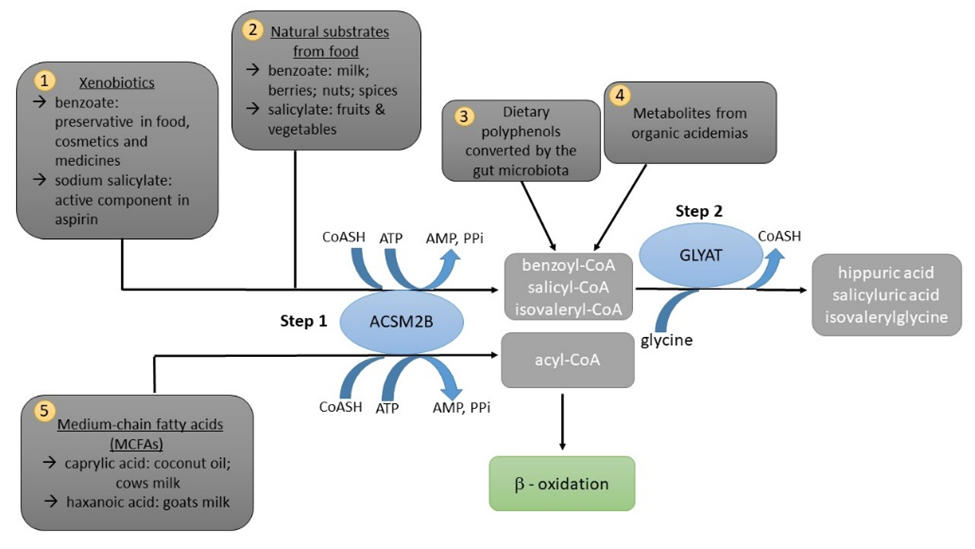Within the group, we have two main focus areas namely the characterisation of the glycine conjugation pathway as well as the development of molecular diagnostic tests for application in animal breeding.
a) Genetic and enzymatic characterisation of the glycine conjugation pathway – a phase II detoxification pathway.
Benzoate (found in milk and widely used as preservative), salicylate (present in fruits and the active component of aspirin), dietary polyphenols produced by gut microbiota, metabolites from organic acidemias, and medium-chain fatty acids (MCFAs) are all metabolised/detoxified by the glycine conjugation pathway (Figure 1). This pathway is a two-step enzymatic pathway whereby xenobiotics are first activated to an acyl-CoA by the mitochondrial medium-chain fatty acid: CoA ligases (ACSMs) and subsequently conjugated to glycine by glycine N-acyltransferase (GLYAT). The MCFAs are activated to acyl-CoA by the ACSMs before entering mitochondrial β-oxidation.

Fig. 1 Schematic representation of the glycine conjugation pathway. Step 1 is the activation of the substrate by ACSM2B and step 2 is the glycine conjugation by GLYAT.
Even though the glycine conjugation pathway was one of the first metabolic pathways to be discovered in 1841, thorough investigation of this pathway was neglected for some time with no new studies published over a period of 12 years (1999 – 2011). We are currently the leading researchers in this field and several studies from our group have contributed to the characterisation of the glycine conjugation pathway from 2013 to present. We characterized the molecular basis for the inter-individual variation observed in the glycine conjugation capacity of for e.g. aspirin (van der Sluis et al. 2013). In a review, we highlighted the significance of this pathway in forming less lipophilic conjugates that can be more easily transported out of the mitochondria. It also pointed out the consequence of a dietary deficiency of glycine in humans due to the increased consumption of benzoate (Badenhorst et al. 2014). We conducted two studies that showed that the glycine conjugation pathway is highly conserved, which supports the hypothesis that the glycine conjugation pathway is an essential detoxification pathway (van der Sluis et al 2015 & van der Sluis 2018). A critical review on the ACSMs pointed out several discrepancies in the literature regarding disease association and the nomenclature of the ACSM ligases were summarised and clarified, aiding the design and reporting of future studies in this field (van der Sluis and Erasmus 2016). We also identified the enzyme catalytic mechanism of the human GLYAT enzyme (van der Sluis et al. 2017). It was shown that GLYAT exhibits mechanistic kinetic cooperativity as described by the Ferdinand enzyme mechanism rather than the previously assumed Michaelis–Menten reaction mechanism.
b) Development of molecular diagnostic methods for application in animal breeding
Development of a parentage verification test that ensures accurate pedigree data for lovebirds
There are nine lovebird species with five of these being kept as popular pet parrots. Although there is a keen interest in lovebird breeding, worldwide, very little molecular genetic research has been conducted in order to develop genetic screening tests for these species. We developed a parentage verification test that ensures accurate pedigree data for lovebirds (van der Zwan et al. 2019). We were the first group to publish the de novo genome for any of the lovebird species and also the first group to develop a SNP-based parentage verification panel for lovebirds.
